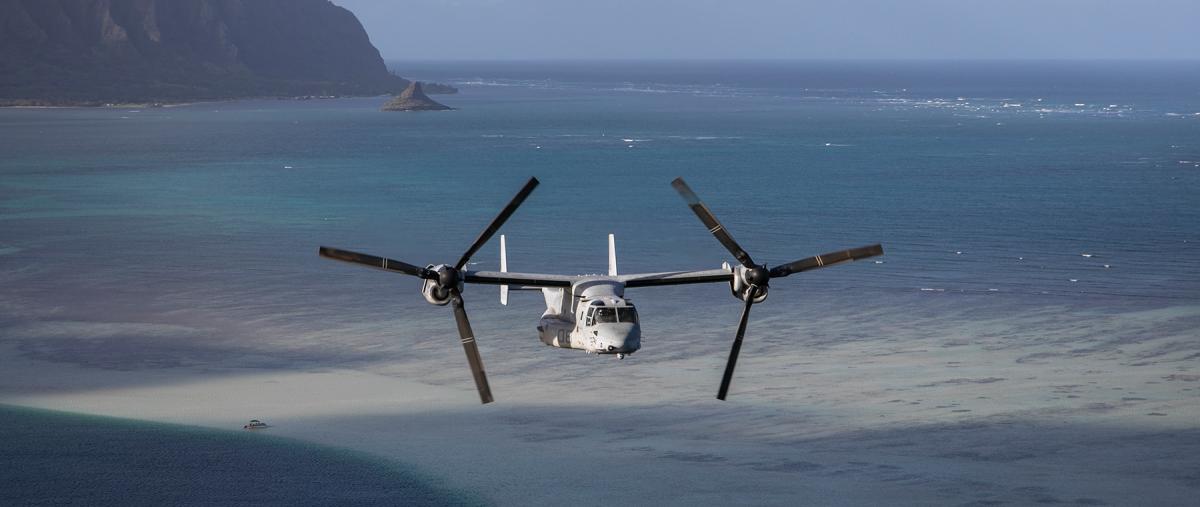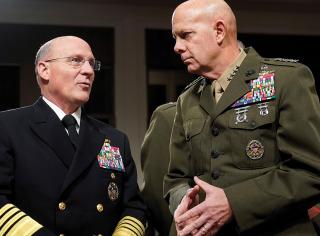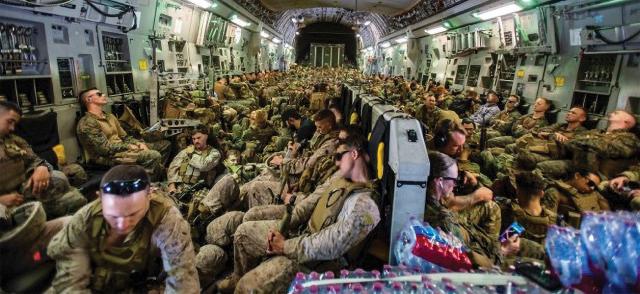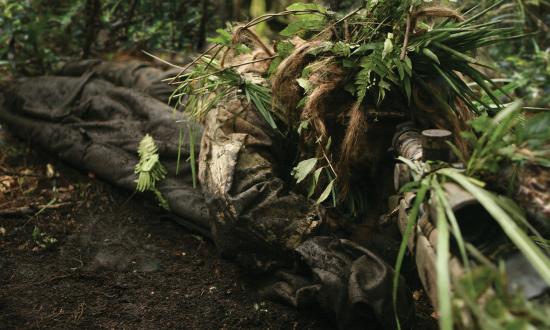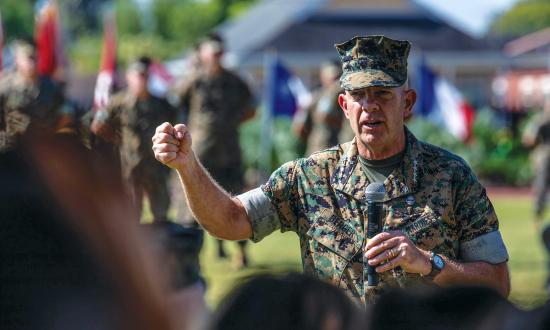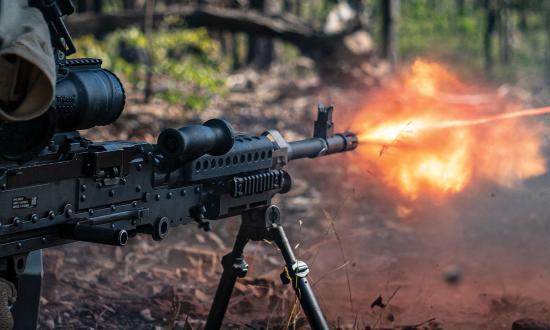In April 2021, the Commandant of the Marine Corps, General David H. Berger, released his first “Force Design 2030 Annual Update,” assessing the progress made since issuing Force Design 2030 in March 2020.1 The update examined the headway the Marine Corps has made toward the development of necessary capabilities and priorities for actions and investments to support naval operations in a contested maritime environment. Understanding of required changes remains incomplete, but the service achieved several milestones, mostly in shedding capabilities that do not fit within the “future objective force.” Testing and development to refine and eventually field new capabilities continued apace, though obstacles emerged. In addition, Marines continued to deploy as expeditionary forces in support of combatant commanders and to improve interoperability with allies and partners.
Divestment
In the “Annual Update,” General Berger writes: “Fiscal realities dictate that we must first divest of legacy programs in order to generate the resources needed to invest in future capabilities. This may create near-term risk that we must manage in order to obtain the 2030 force we require.”2 In many ways, these realities defined 2021.
The most striking divestment was the elimination of both remaining active-duty tank battalions, following the deactivation of the reserve 4th Tank Battalion in 2020. The Commandant has written that heavy ground armor “is operationally unsuitable for our highest-priority challenges in the future.”3 The expectation is that, if the firepower of heavily armored tanks and bridging is required in future contingencies, the Army will provide units that will attach to Marine Corps operating forces.
The 2d Tank Battalion at Camp Lejeune, North Carolina, conducted a deactivation ceremony on 5 May, while the 1st Tank Battalion in Twentynine Palms, California, furled its colors on 24 May. The Marine Corps is transferring all its tanks to the Army, while the Marine tankers and tank maintainers have been offered several options for their futures, including changing their military occupational specialties to other fields, transferring to the Army, or leaving the service early. The last bridging company also was eliminated in 2021.
A key element of General Berger’s “objective force” (that is, the force that is the object of redesign efforts) is reducing it by some 12,000 Marines by 2030.4 Significantly, considering the Marine Corps’ historical “every Marine a rifleman” emphasis, these reductions include the elimination of one infantry regimental headquarters, three active-duty infantry battalions, and two reserve infantry battalions. Initial steps in this plan began in January, with the deactivation of 8th Marines’ regimental headquarters at Camp Lejeune. In June, shortly after returning from deployment to Japan, 3d Battalion, 8th Marines, furled its colors. The two remaining battalions in the regiment were reassigned to the other two infantry regiments in 2d Marine Division—1st Battalion, 8th Marines, to 6th Marines and 2d Battalion, 8th Marines, to 2d Marines. Two more infantry battalions are slated for deactivation in 2022.
The elimination of infantry units enables proportional cuts in some supporting capabilities. This included the continued deactivation of MV-22 Osprey squadrons to meet the new force objective of 14 squadrons. In October, Marine Medium Tiltrotor Squadron (VMM) 166 was deactivated at Miramar, California. Additional cuts across the force are in progress and are expected to be accomplished before 2030.
Other key divestitures in progress include the reduction from seven to five light attack helicopter (HMLA) squadrons, equipped with the recently upgraded AH-1Z and UH-1Y model aircraft, and from eight to five heavy-lift helicopter (HMH) squadrons, which are beginning to field the new CH-53K King Stallion to replace CH-53Es. The Commandant has not decided on the required cuts to the number and type of F-35 fighter attack (VMFA) squadrons. He has directed continued analysis to determine “VMFA capacity requirements as well as the appropriate F-35B/C mix of aircraft.”5
Preliminary Force Redesign
Beyond eliminating types and numbers of units that do not fit into the projected force required for operations in a contested maritime environment, the Marine Corps also shed key operational commitments in 2021. Three special purpose Marine air-ground task forces (SPMAGTFs) that had been established to support combatant commanders’ expanded force requirements with ground-based expeditionary units rather than amphibious forces were ended during 2021. SPMAGTF–Crisis Response–Central Command (SPMAGTF-CR-CC) based in the Persian Gulf region ended in October, when the last rotation unit of about 2,000 ground, aviation, and logistical support personnel was not replaced.6
Similarly, the Marine Corps ceased providing rotational forces for SPMAGTF-CR-Africa based out of Spain, which was initiated in 2013 in response to the 2012 attack on the U.S. embassy in Benghazi, Libya. However, a tiltrotor MV-22 squadron that moved from Spain to Sigonella, Italy, will continue to deploy and support Army forces based in the region. The squadrons also provide detachments to support operations around the Horn of Africa, operating from Camp Lemonnier, Djibouti. The SPMAGTF-Southern Command that stood up in 2014 and was headquartered out of Honduras also ended operations in 2021, a move expected to save $3 million a year.7
This was not a year in which significant additions were made toward fielding new objective force capabilities. Progress was made in some key developing capabilities, however, including increased experimentation with long-range precision fires in support of naval operations. Two artillery batteries were stood up in the 10th Marine Regiment at Camp Lejeune that will provide the 2d Marine Division with the High-Mobility Artillery Rocket System (HIMARS). The regiment conducted its first live-fire training using HIMARS during its spring 2021 Rolling Thunder exercise at Fort Bragg, North Carolina. In July, Marine Corps and Army HIMARS batteries supported Talisman Saber, the large biennial multinational exercise in Australia. Marine KC-130J and Australian C-17 aircraft shuttled artillery units to distributed small expeditionary bases from which the precision-guided rockets simulated support of sea-denial and sea-control operations.8
More significant, in April, developers tested the Navy–Marine Corps Expeditionary Ship Interdiction System (NMESIS), which combines a modified, unmanned Joint Light Tactical Vehicle with the proven Naval Strike Missile, a 100-nautical-mile precision antiship weapon currently being installed on littoral combat ships. The missile was launched from the Point Mugu Sea Range on the California coast and hit a target at sea.9 In August, the Marine Corps again demonstrated NMESIS, this time as an integrated capability during the naval Large-Scale Exercise 2021, when two antiship missiles were fired from Kauai, Hawaii, and hit a decommissioned ship target.10
NMESIS currently is funded to support testing and evaluation for research and development, but not yet to procure launchers and support equipment or to enable transition of identified artillery cannon batteries to antiship missile batteries. In its FY 2021 budget, the Marine Corps had requested $125 million to buy nearly 50 Tomahawk missiles for a more robust sea-denial capability, but Congress did not approve the request. In March, the then-Commander, U.S. Indo-Pacific Command, Admiral Phil Davidson, told lawmakers the “decision to slash those funds hurt the military’s ability to deter China.”11
Ship to Shore
The tragic sinking of a Marine amphibious assault vehicle (AAV) on 30 July 2020 off San Clemente Island, California, with the loss of eight Marines and one Navy corpsman, continued to reverberate across the Marine Corps in 2021. Three investigations into the accident and the 1970s-era vehicle were released.
The first Marine Corps command investigation completed in February reviewed the state of AAV equipment, procedures, and training and recommended improvements to each area. A subsequent investigation by the Commander, Marine Corps Forces Central Command, Lieutenant General Carl E. Mundy III, focused on the formation of the 15th Marine Expeditionary Unit (MEU). This “investigation found a confluence of factors, including COVID-19 impacts, task-saturation and reduced manning, poor communication, and inadequate training and equipping played significant roles in contributing to the conditions that allowed for the tragedy to occur.”12 A Navy investigation completed in July focused on the role of the USS Somerset (LPD-25)—the ship the AAVs had launched from and were returning to when the accident occurred—along with the potential contribution of Navy personnel to the tragic event. While it recommended policy and procedural improvements, it did not find any culpability.13
In parallel with these investigations, senior naval officers conducted the “Strategic Review of Amphibious Operations” to build on the findings and recommendations of the official investigations and, more important, “assess all aspects of current amphibious operations with special consideration for future concepts of amphibious operations.” This highly experienced board included retired Marine Corps General Thomas Waldhauser, along with two retired Marine lieutenant generals, three retired senior Navy flag officers, and a retired Coast Guard vice admiral. While the official results of the review have not yet been released, the Commandant accepted one recommendation in December when it was announced that the Marine Corps would no longer permit AAVs to conduct waterborne operations and that these vehicles will not support regular MEU deployments or training exercises in the future. The only exception would be if they were needed to respond to a crisis.14
Part of the rationale for this restriction was the decision to accelerate the fielding of the wheeled amphibious combat vehicle (ACV), which entered full-rate production in late 2020. The Marine Corps plans to acquire 632 ACVs (a reduction in accordance with Force Design 2030 from a previous acquisition objective of 1,122 ACVs) from BAE Systems in four variants—a personnel carrier, a recovery vehicle, a command-and-control variant, and a gun vehicle with a mounted 30-mm cannon.15 However, General Berger also seeks to develop additional capabilities on the vehicles, including electronic warfare systems, sensor fusion, and loitering munition launchers.16 Fielding the ACV is projected to be completed in 2028, with five ACV companies in the active-duty force and two in the reserve. The last tracked AAV is now scheduled to leave the inventory in 2026. MEUs deploying from the West Coast are expected to operate ACVs starting in 2022. East Coast MEUs will have a gap in organic self-deploying amphibious ship-to-shore connectors until about the last quarter of fiscal year 2023.
Out of an abundance of caution, ACVs also were restricted from waterborne operations in September 2021, in part because of deficiencies identified in towing equipment and procedures. However, these restrictions were lifted in early January 2022, and the assigned ACV unit will soon resume open-water workup training for deployment with the 13th MEU.17
Study. Test. Repeat.
Many new capabilities are still in development in what the Commandant has defined as the “Campaign of Learning” that seeks to “continuously refine the details of our modernization plan, making adjustments to our approach to achieve the Objective Force.”18
One critical initiative is the Marine Corps Warfighting Laboratory’s Infantry Battalion Experiment 2030 (IBX30). Three battalions are being organized in different configurations. They will assess the design of the future infantry battalion to best conduct expeditionary, offensive, and defensive operations as an element of a MEU, the new Marine littoral regiments, or an infantry regiment.
The focus areas for this iterative experiment include enhanced command and control, sensing, lethality, and sustainment. One battalion will employ the current infantry battalion design with some additional troops and equipment to assess its ability to operate in a distributed environment. Another experimental battalion will be smaller and lighter than a current infantry battalion, with about 735 Marines equipped with newer weapons and systems under development.
The 3d Battalion, 3d Marines, stationed in Hawaii, began its transformation to this experimental force in 2021 and participated in the large-scale integrated training exercise at Twentynine Palms, California, in the fall. Its personnel will be more experienced, be cross-trained on multiple weapons, and possess capabilities such as electronic warfare and others necessary to operate in a contested information environment. The structure and capabilities of the third IBX30 battalion will fall in between those of the other two.19
A priority requirement for the experiments to validate is the equipping of infantry units with unmanned aircraft that provide loitering, organic precision fires. This emerging requirement is directly related to immediate lessons from the Second Nagorno-Karabakh War in 2020, “in which the victor imposed their will primarily through the use of unmanned systems and loitering munitions.”20 The Marine Corps anticipates that these organic precision-fire systems—including “kamikaze drones”—will provide infantry units with a range of close-in and longer-range fires and antiarmor capabilities in the absence of tanks. And with cannon artillery converting to long-range rocket and missile systems, infantry battalions are shedding heavier capabilities such as medium mortars. Organic precision-fire weapons are not anticipated to be fielded until FY 2024 or 2025. Whether these organic systems can provide the sustained capacity, breadth of required ranges, and scope of effects will need to be robustly assessed in operational analyses, war-games, and—most important—during live experiments and exercises.
The Commandant also has written that “half our aviation fleet being unmanned in the near to midterm” is possible.21 The FY 2022 budget requested funding for six MQ-9A Reaper unmanned aerial systems, which would equip three new medium-altitude, long-endurance unmanned aerial vehicle (UAV) squadrons.
Follow the Money
Congress passed a continuing resolution for FY 2022 instead of a formal budget, which will negatively affect significant elements of the current plan. In testimony, the Commandant stated that the continuing resolution “delays and degrades the Marine Corps’ Force Design effort and increases our risk in strategic competition.” He cited examples of modernization and readiness programs critical to warfighting that will be affected. These include delaying efforts to accelerate fielding the ACV and NMESIS systems, reducing MQ-9A aircraft procurement from six to zero, reducing the number of KC-130J tankers from six to five, limiting the F-35B buy to 10 from 17, and pushing back the development timeline for the organic precision-fire system.22
In addition, General Berger is concerned about the hesitation from Department of the Navy and DoD officials regarding the light amphibious warships (LAWs). It is anticipated that 24 to 35 of these ships, capable of moving 75 to 125 Marines and light gear, would provide long-range, risk-worthy connectors to support mobile expeditionary advanced bases and stand-in forces within range of enemy antiaccess systems.23 Advanced bases operating in the littorals would support integrated naval long-range fires, extended aviation capabilities, and sensors and intelligence systems; enhance force protection; and provide command and control in support of the fleet’s sea-control campaign. As a recent concept paper describes them, stand-in forces are “small but lethal, low signature, mobile . . . forces designed to operate . . . as the leading edge of a maritime defense-in-depth in order to intentionally disrupt the plans of a potential or actual adversary.”24
At two speaking events in December, the Commandant indicated that reversing commitment to critical new capabilities in Force Design 2030 now, after significant divestments have already been made, would leave the Marine Corps in the “lurch.”25 While it has been suggested that funding for traditional amphibious warships could be diverted to pay for LAWs, it also is apparent that the distributed nature of and long distances inherent in operations in the Indo-Pacific region require more and varied platforms for mobility and maneuver. General Berger says the Marine Corps is “looking at [new] ways to use traditional amphib ships” including as “motherships” for unmanned air, surface, and underwater systems.26
Besides programmatic challenges, some critics worry about the fundamental assumption underlying Force Design 2030 and its objective force. Retired Marine Colonel Mark F. Cancian enumerated several specific concerns in a late-2021 Center for Strategic and International Studies paper.27 These include whether optimizing the force for naval operations focused on China will hinder the Marine Corps’ ability to be responsive and effective as an “expeditionary force in readiness” for operations beyond great power conflicts and in regions outside the Indo-Pacific littorals. Colonel Cancian highlights that the “new war-fighting concepts are unproven” and that necessary logistical support for highly intense combat may not be fully appreciated. He also expresses concern that the new force structure’s focus on long-range precision fires creates gaps in close-in firepower an adaptive and capable enemy could exploit. Others have questioned whether the redesigned force will possess capabilities required after a successful sea-control fight, such as power projection, which the legacy force was structured and trained to conduct.
Personnel
Recognizing the vital importance and role of the individual Marine in reshaping the Corps, in November, General Berger issued Talent Management 2030.28 In this guidance, he directs a fundamental change to the personnel system to recruit, train, and retain Marines with the capabilities necessary for Force Design 2030 and the emerging warfighting concepts.
Beginning in 2022, the Marine Corps will recalibrate its enlisted personnel model away from a force that typically discharges about 75 percent of its first-term Marines and requires recruiting and training approximately 36,000 new Marines each year. The expectation is that “maturing the force by retaining a greater percentage of qualified first-term Marines will improve decision-making, problem solving, and risk assessment among our junior leaders, with immediate positive effects on our performance in competition and combat.” The guidance also proposes other initiatives, including a plan to employ “online marketplaces” to allow personnel to submit resumes and compete for some assignments.
Quality-of-life improvements in the plan include increasing parental leave and reducing the number of permanent changes of station moves in a career. The Commandant also recognizes a need to create a path for “lateral entry” that will provide “an open door for exceptionally talented Americans who wish to join the Marine Corps, allowing them to laterally enter at a rank appropriate to their education, experience, and ability.”
Aging the force is an expensive proposition, and it is unclear if reducing its size, decreasing demand for recruiting and recruit training, permitting fewer moves, and other savings will pay for the new personnel model. However, it is clear the technology and requirements for multiskilled, extensively cross-trained Marines for the new war-fighting concepts demand a more mature force. The potential tangential issues inherent in some of the planned changes—e.g., homesteading, resentment over entry sources and promotions, sustaining close ties with the American public, etc.—while certainly real, appear to be manageable through effective leadership and expectation management.
First to Fight
Two deployments were highlights of Marine Corps operations in 2021. Early in the year, the President ordered the completion of operations in Afghanistan and removal of forces by the end of August. As the Taliban accelerated its seizure of provinces and got closer to the capital, in mid-August two Marine Corps units—demonstrating the value of expeditionary ready forces—deployed rapidly along with an Army battalion to support the withdrawal of American personnel and the evacuation of Afghan allies through the Hamid Karzai International Airport in Kabul. The 24th MEU (already operating in the region) sent a force built around its Battalion Landing Team 1/8, and SPMAGTF-CR-CC’s 2d Battalion, 1st Marines, also deployed to the airport. The chaotic conditions at the evacuation site increased as the Afghan government and security forces collapsed, and thousands of Afghans and other nationals tried to get to the airport. On 26 August, a suicide bomber from the Islamic State’s Afghanistan affiliate detonated an explosive near the crowded Abbey Gate of the airport where a Marine unit was providing security, killing more than 180 people and injuring another 150. Thirteen U.S. personnel were killed, including 11 Marines, a Navy corpsman, and an Army soldier.
The joint force conducted the largest noncombatant evacuation in history, with almost 130,000 people able to “find a better and freer life” amid a messy and uncertain situation.29 However, the precipitous fall of Afghanistan, which the United States had invaded in the wake of the 11 September 2001 attacks, the unsettling and deadly events at the Kabul airport, and the decision to abandon Bagram Airfield are still generating questions about the reliability of U.S. partnerships and global security commitments, the state of civil-military relations, and the assignment of accountability. Most notable in the immediate aftermath was the public criticism of senior military and political leaders by an active-duty Marine officer, Lieutenant Colonel Stuart Scheller Jr. His insubordinate public accusations in violation of military law resulted in charges brought against him, pretrial confinement, and his eventual discharge from the service.
The other significant Marine Corps operation was the embarkation in May of VMFA-211, an F-35B squadron, on board the British aircraft carrier HMS Queen Elizabeth alongside a Royal Air Force F-35B squadron. The carrier strike group, which also included a U.S. Navy guided-missile destroyer and a Dutch frigate, cooperated with forces from more than 40 nations during its seven-month deployment. The integration of the Marine Corps squadron on an allied ship highlighted the potential for expanded employment of interoperable multinational naval task forces in today’s contested maritime environment and tense global strategic disputes.
Highlights of the carrier strike group’s global deployment and operations by VMFA-211 included exercises with the Iwo Jima Amphibious Ready Group and Norwegian naval forces in the North Atlantic and Baltic Sea; dual-carrier operations with the French aircraft carrier Charles de Gaulle; combined combat strikes against ISIS forces in the U.S. Central Command theater; interoperability exercises with aircraft from the USS Carl Vinson (CVN-70) in the Philippine Sea; exercises with Japanese, South Korean, Australian, and other Indo-Pacific naval forces; a freedom-of-navigation operation across the South China Sea; cross-decking exercises with the USS Essex (LHD-2) and the 11th MEU in the Gulf of Oman; and cross-decking and interoperability exercises with the Italian Navy’s aircraft carrier Cavour and its F-35B aircraft in the Mediterranean.
Overall, 2021 was a year of change that witnessed important milestones in shifting the ship’s rudder and placing the Marine Corps on course toward the Commandant’s objective force. The service made progress in shedding capabilities deemed superfluous and in laying key steps for implementing and refining necessary enhancements and new capabilities. The next two years will be critical in testing and validating these changes and overcoming programmatic challenges.
1. Gen David H. Berger, USMC, Force Design 2030 (Washington, DC: Headquarters Marine Corps, 2020); Gen David H. Berger, USMC, “Force Design 2030 Annual Update” (Washington, DC: Headquarters Marine Corps, 2021).
2. Berger, “Annual Update,” 5.
3. Berger, Force Design 2030, 8.
4. Berger, 7.
5. Berger, “Annual Update,” 3.
6. Chad Garland, “Marines End Crisis Response Force Rotations in Africa, Middle East in Favor of Airlifting Army Troops,” Stripes.com, 18 November 2021.
7. Philip Athey, “Marine Corps Shuts Down Southern Command Rotational Deployment,” Marine Corps Times, 20 June 2021.
8. Seth Robson, “Marine and Army Gunners in Australia Practice Techniques for Deterring Warships,” Stripes.com, 20 July 2021.
9. Todd South, “Marines Strap Missile to Truck and Strike Target at Sea,” Marine Corps Times, 30 April 2021.
10. Justin Katz, “Marines Successfully Fire New NMESIS Anti-Ship Weapon During Live Exercise,” Breaking Defense, 17 August 2021.
11. Gina Harkins, “Marines Fire Anti-Ship Missile from Back of Unmanned Truck to Hit Target at Sea,” Military.com, 29 April 2021.
12. “Department of the Navy Concludes Investigations into Assault Amphibious Vehicle Tragedy,” press release, 7 October 2021.
13. “October AAV Investigation Report Redacted,” Commander, Third Fleet, 15 September 2021.
14. Sam LaGrone, “Marines Keeping AAVs Out of the Water Permanently,” USNI News, 15 December 2021.
15. Congressional Research Service, The Marine Corps’ Amphibious Combat Vehicle (ACV) (Washington, DC: CRS, 4 February 2021).
16. Berger, “Annual Update,” 11.
17. Todd South, “Marine Amphibious Combat Vehicles to Return to Waterborne Operations,” Defense News, 7 January 2022.
18. Berger, “Annual Update,” 4.
19. Caitlin Kenney, “The Marine Corps Is Redesigning Infantry Battalions for the Future,” Defense One, 23 June 2021.
20. Berger, “Annual Update,” 2.
21. Hon. Thomas W. Harker, Department of the Navy Unmanned Campaign Framework (Washington, DC: Department of the Navy, 6 March 2021), 3.
22. Gen David H. Berger, USMC, “Statement to the House Appropriations Committee Subcommittee on Defense on the Impact of Continuing Resolutions on the Marine Corps,” 12 January 2022.
23. Ronald O’Rourke, Navy Light Amphibious Warship (LAW) Program: Background and Issues for Congress (Washington, DC: Congressional Research Service, 9 December 2021).
24. Gen David H. Berger, USMC, A Concept for Stand-In Forces (Washington DC: Headquarters Marine Corps, December 2021).
25. Megan Eckstein, “US Marine Commandant: Fund ‘Force Design 2030,’ or Leave the Corps in a ‘Lurch,’” Defense News, 14 December 2021.
26. Stephen Losey and Megan Eckstein, “Berger: I’ll Accept a Smaller Marine Corps to Make Light Amphibs Happen,” Defense News, 8 December 2021.
27. Col Mark F. Cancian, USMC (Ret.), U.S. Military Forces in FY 2022, Center for Strategic and International Studies, November 2021.
28. Marine Corps, Talent Management 2030 (Washington, DC: Headquarters Marine Corps, November 2021).
29. Philip Athey, “7 Marines Still Hospitalized Weeks after Kabul Airport Suicide Bombing,” Marine Corps Times, 15 September 2021.



